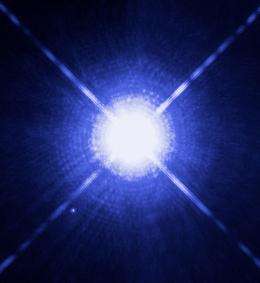September 29, 2014 feature
A Higgs-gravity connection may leave traces in white dwarfs

(Phys.org) —The discovery of the Higgs boson at the Large Hadron Collider (LHC) in 2012 marked an important step toward understanding the origin of the mass of fundamental particles. Since mass plays a major role in gravity, the Higgs could also reveal insights into the nature of gravity. One possibility is that the Higgs field could couple to a specific spacetime curvature, a scenario that is invoked in various extensions of the standard model.
Now, scientists have shown that dying stars called white dwarfs can be used to investigate and place limits on the coupling between the Higgs field and spacetime curvature. The study, by Roberto Onofrio at the University of Padova in Italy and the Harvard-Smithsonian Center for Astrophysics in Cambridge, Massachusetts, and Gary A. Wegner at Dartmouth College in Hanover, New Hampshire, is published in a recent issue of The Astrophysical Journal.
"Conceptually, I think that our work is trying to create a 'common' language between microphysics and macrophysics in the following sense," Onofrio told Phys.org. "So far, people have looked for the consequences of the Higgs field in the microworld, at the so-called Fermi scale, i.e., the attometer scale (1 am = 10-18 m), and for the consequences of gravity at the macroscopic scale, from an apple upward in terms of size and masses. Yet, both have in common the central role that mass plays in the standard model of elementary particle physics and in gravitation. So by starting to talk of masses involving both the Higgs field (which is supposed to give inertial mass to all fundamental particles) and gravitation (where the gravitational mass of a body is a key concept), one can check for their consistency or for the presence of possible contradictions."
A handful of high-gravity astrophysical objects, such as primordial black holes and active galactic nuclei, have been proposed to investigate crosstalk between the Higgs and gravity. However, white dwarfs have the unique advantage of showing both molecular and atomic lines in their light emission spectra. Since the Higgs-curvature coupling is expected to affect the atomic lines, but not the molecular lines, a comparison of both lines is needed.
The reason that the coupling only affects atomic lines is due to the different origins of the electron mass and the masses of protons and neutrons (nucleons). Most of the nucleons' mass arises from massless gluonic fields; being massless, they do not couple to the Higgs field. Molecular transitions that only depend on the nuclei mass, therefore, are not affected by the Higgs-curvature coupling. In contrast, the Higgs-curvature coupling does affect the mass of electrons and other fermions by adding to these particles' inertial masses.
White dwarfs contain large amounts of carbon and emit a distinct spectrum involving vibrational spectra as well as vibronic transitions between electronic states. In the presence of a Higgs-curvature coupling, the vibrational levels, which are proportional to the nucleon mass, should stay constant. However, the electronic energy levels, which are proportional to the electron mass, should be shifted.
The electron mass shift induced by the Higgs field sets an upper bound on the coupling between the Higgs field and spacetime curvature that is 10 orders of magnitude more stringent than bounds set by table-top experiments based on tests of the superposition principle for gravitational interactions. The new bounds are also the first set on this coupling by an astrophysical object.
Understanding the Higgs-curvature coupling has several implications. A variety of proposed models that invoke this coupling suggest that the Higgs may play the role of the inflaton, or that the Higgs may serve as a mechanism to suppress the dark energy contribution of quantum fields to the level compatible with observations.
In the future, the spectroscopic analysis could be improved by observing signals from additional white dwarfs, and perhaps extended to the case of stronger gravity neutron stars, though it is hard in this last case to detect spectroscopic features.
More information: Roberto Onofrio and Gary A Wegner. "Search for Higgs Shifts in White Dwarfs." The Astrophysical Journal. DOI: 10.1088/0004-637X/791/2/125
Journal information: Astrophysical Journal
© 2014 Phys.org



















